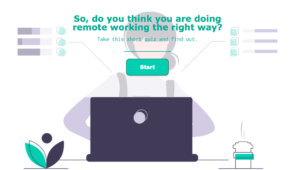Remote Work: Tips & Tricks From Startups Who Have Been Mastering It For Years

It’s been around ten days since a large part of the business in Bulgaria have switched to a remote model of working due to the outbreak of coronavirus and the measures to stop the spread. And while for the tech sector it’s relatively easy to adjust due to the specifics of the work, for more traditional sectors the concept of working from the couch or the kitchen table is a bit unusual.
From managing projects to maintaining the motivation within the teams – there’s a whole load of details that need to be thought through. And yes, we know what’s going on. HRs are thinking about what initiatives they should come up with to engage the employees. Managers are rethinking what to do – try to grab new opportunities, while being worried about the current state of things. Employees are readjusting to new procedures. And everyone is consuming loads of information, relevant and irrelevant content, spending more time in chats and Zoom than ever, feeling weird as if it’s kind of a busy weekend all the time.
In the middle of all that, we asked founders, CEOs, and CTOs, for whom remote is actually the way things usually go, about their practices, rituals, and tools. Let us don’t forget that the situation is slightly different, but still, you maybe find some useful tricks:
Vladimir Tsvetkov, CTO Noble Hire: Right now leadership confidence is essential, organization comes second

At the moment Vladimir is CTO of Noble Hire, a digital hiring platform specialized in the IT sector. His team of 12 is only partially remote, the others are usually in the office (well, obviously not right now), and features different nationalities, therefore the official communication language is English. He is also CEO of hacker.works, a software development company that works predominantly remote.
What are the biggest challenges of remote work?
What is missing in the remote setup is the option to have informal and not-work-related conversation. And these are the types of conversations that usually happen between the tasks and in the lunch break – this is also the type of interaction and exchange of ideas that is a fertilizer for innovation within a team.
I’m keener on teams that manage to minimize meetings and interruptions between each other. Literally, in the ideal case for me, after a short stand-up everyone should be able to proceed to their projects and tasks autonomously. Not least, working remotely shouldn’t be used as an excuse to increase the online communication.
What practices, methodologies, rituals and tools can you recommend?
Let me be first clear about something – I don’t believe any tool could substitute self discipline. Companies should be generally looking for people who are conscientious and self critical.
In the past 5-6 years the remote stack we use hasn’t changed a lot – a good tool for conference calls, collaborative text editors, sheets and slides (for instance the Google Suit). And of course, in the tech space – GitHub, combined with a code review tool, instant messaging like Slack or Discord, and email. I’d also recommend Whiteboard, a visual collaboration tool.
What should managers think about in advance when reorganizing work?
From a leadership standpoint, it’s important to communicate confidence during the crisis, and vision about the future in order to motivate the team to continue with its work. Right now it’s extremely easy to fail into cynicism and disbelief. We more than ever need to communicate as leaders and demonstrate confidence. The organization of the work is indeed secondary.
Can you think of advice for people who now need to work remotely on how to stay productive?
I’ve seen two types of people – for the first ones the start of the day is related to going somewhere, for the second group it’s related to a drink. I’m from the second type. The first ones should try to organize their working spot in a separate room, or try to start their day with preparing a drink for themselves – a coffee, cappuccino, tea, or whiskey if they need to.
______________
Pavlina Desheva, founder of Webdesh: Set ‘quiet time’ for bigger projects and announce it to everyone

Pavlina is the cofounder of WordPress development agency Webdesh and the leader of an almost completely female and 100% remote team of ten people. The core team is in Sofia, but there are freelancers from Dobrich, Silistra and other places in Bulgaria. Right before the outbreak they rented an office (after working remotely for years), and are now back to their remote normality.
What are the biggest challenges of remote work?
I have forgotten what it’s like not to work remotely. I guess having new team members is more challenging in terms of them getting to know the team and the process. Sometimes staying aligned with each other’s work and tasks can be more difficult, but having the tools and processes to keep this up-to-date helps a lot.
What practices, methodologies, rituals and tools can you recommend?
Communication, planning, clear priorities and adaptability – these are the key factors that help us be productive while working away from each other.
We have co-working days (at least 2 in a week in normal circumstances), just to connect better as a team and to progress faster on small and ongoing tasks. Whether we are together or not, we have “quiet time” (at least 2 hours) so that each of us can focus on bigger tasks.
Using specific and strictly determined communicational tools is key. We use 3 things:
- Discord (similar to Slack) for discussions
- Asana comments to track task’s progress, challenges, deadlines
- and phones if we need to (usually with clients or for team brainstorming)
- More tool ideas here
We don’t miss a daily call, we do scrum and keep in touch during the whole day (and often – night… we do IT/design stuff after all so we are quite productive during small hours :)). In our team we care about each other so we don’t rush the calls – we take our time to ask each other how we feel, how are we, etc. and then we jump on the work specifics and updates.
Learning on the go and celebrating wins is key for keeping up with the good work at Webdesh, so we try to make learning sessions on the go (the moment somebody learns something – they share it with the team over a video call or Discord #knowledge channel and we drink wine when we launch a new website (we are 80% women in the team ;)).
Can you think of one piece of advice for companies that need to restructure to remote work as quickly as possible? What should managers think about in advance when reorganizing work?
For the management team: This can be a weird time for your team, if they aren’t used to working remotely. So the 1st thing I would say is that their results are the direct product of your management and operations. So focus on results, not on the time spent on them. Set strict deadlines, have clear expectations about each team member and each of their tasks and check on them in order to help them deliver, rather than push and evaluate. People sense when you trust them, so it is the management and operational work to be able to inspire them towards good results, rather than going into the role of a babysitter, making sure they are not playing games all day long. Be available as much as possible for brainstorming and questions from the team – this is the time when they need to feel that someone has their back. And it’s not that bad if they play games from time to time – if they deliver within the deadlines, let them feel free to manage their own time, but also have their priorities straight in the beginning of each day (on the daily call) and beginning of each week (with weekly priorities for every team member – for smaller teams up to 10 people – the whole team; for bigger companies – do this per teams/roles/projects).
For the Project Manager /Team Lead it would be very, very important to update each morning all deadlines to all tasks and ask for update for each task if there is not one provided the previous day. If needed during the transition period – send each team member a list with their priorities for the day, so that you make sure they work on the most important things.
Can you think of advice for people who now need to work remotely on how to stay productive?
At Webdesh we recently had a productivity training which is great, since it reminds you of the basics and gives perspective to the team. You can have this as well – remind them that during “quiet time” all notifications should be off, to check their emails 2-3 times a day and answer right away, but not too often, to put all their meetings in a shared calendar and to update the status of every task in your project management system. If all this is in place and you don’t miss the daily “stand-up” calls, you should be just fine.
Some of my favorite productivity rules:
5-minute rule – if you have already broken your focus with something (checking an email) and if it takes less than 5 mins to do – do it right away (no exceptions).
“quiet time” – announce it (or if your company has it as a rule – don’t break it). During this time you need to focus on bigger, more creative tasks and your teammates too, so show some respect and don’t ask questions unless absolutely necessary. Instead, write down all your questions and comments and ask them when this quiet time is over. Also, people will write messages and emails, etc. It is your responsibility to switch off your distractions, turn off notifications, close the useless tabs and focus on your big task. Everything will be waiting for you after you finish and if something is very urgent, believe me – you will know.
Take time off. Each hour for 3-5 mins just relax. I love the mouse experiment – if a mouse is placed in water, for 14 mins it drowns, but if just before these 14 mins have finished, you lift it up and give her 20 seconds of rest, the mouse can last 60 hours in the water (with these breaks in every 14mins).
______________
Elisaveta Georgieva, Aeternity: Daily standup is a must, but appoint a moderator

Elisaveta is the marketing and communications manager of Aeternity Ventures, the venture arm of the blockchain 3.0 platform of the same name. Her team of 12 is mostly based in Sofia, but there are also three people from Croatia, one from Monte Negro and one from Turkey. Aeternity Ventures has different projects – organizing blockchain accelerator Starfleet, following up with the blockchain startups from all completed editions, various projects for growing and supporting the ecosystem – organizing and hosting a podcast, local blockchain events…and all of this is done remotely. Although there’s also an office in Sofia.
What are the biggest challenges of remote work?
Since our team is based in several different countries we are now quite experienced in remote working. The biggest challenge might lie in communication. After all, face to face communication has the advantage of observing and perceiving your interlocutor and get information from the non-verbal communication as well – facial expressions, gestures, eye contact, tone of voice, etc. This is why we came up with quite an efficient way of communication. We are having daily calls, we have a team chat, we keep our communication clean and snappy and we always keep the good mood up! 🙂
What practices, methodologies, rituals and tools can you recommend?
The daily startup (means standup meeting – ed.n.) is a must. It should be done early in the morning. Questions to be asked and answered during the standup are: What did you do yesterday? What will you do today? What blockers stand in your way?
These calls should be kept short and snappy. We suggest you appoint a moderator, who keeps the order and takes minutes while all the rest of the employees are listening actively. We do it all together every day at 9:30.
What tools would you recommend?
Whereby for daily startups. The advantage of Whereby in comparison with Zoom is that the meeting room link remains unchanged, once you register it. No need to create a new meeting and send invitations and reminders every day. A real time saver. A daily occurring event invitation is created only once in Google calendar.
Wire for instant messaging. Basecamp for project management. This platform is the ultimate project management tool for us. If you are unfamiliar with it, here is a screenshot from my dashboard, just to get the idea. We track progress, assign tasks, make to-do lists, share weekly goals, chat (via Campfire), and more. I’ve summarized an example of how we use it here.
Can you think of one piece of advice for companies that need to restructure for remote work as quickly as possible?
Right now what companies should provide to their employees is understanding and alternative. We live in a digital era. High productivity does not necessarily mean 8 hours spent in the office. Providing employees with space to grow and be creative will most definitely have a positive impact on their problem-solving skills.
What should managers think about in advance when reorganizing work?
Think of what every single employee style of work is. Continuous reminders that everyone is welcome and can approach the manager at any time and ask for help will be also appreciated.
______________
Radoslav Stankov, Product Hunt: Measure output, not input.

Radoslav is the head of Product Hunt’s distributed engineering team, a team that’s spread across three continents and seven time zones. He has spent nearly his entire career, which started back in 2002, as a part of a remote workforce.
Can you think of one piece of advice for companies that need to restructure to remote work as quickly as possible?
In a remote setup, communication is the key. Have clear channels of communication if you use Slack or similar tools – create fun channel, designated channels for projects, for emergencies and news. Reduce the need for video calls.
The remote work, in general, requires 2X the process, and this leads to a more flexible organization overall.
What should managers think about in advance when reorganizing work?
This advice is general, even if not a remote setting. Measure output, not input. Give your team members clear tasks and time expectations and make sure the time commitments are reasonable.
Help your team to adjust. Especially in this situation, the managers have to be understanding that the performance of their team will decrease. People are worried. Don’t think people are not productive, just because of remote setup.
Can you think of advice for people who now need to work remotely on how to stay productive?
Kick start your day by doing something that makes you feel accomplished: make your bed, clean something.
Keep your routine. Wake up at the time you usually wake up for work, do your regular routines. Dress up for work. Have a designated place to work. It should be isolated as much as possible. Try to keep your regular working hours, have a lunch break.
Whatever you do, don’t turn on the TV.
Especially at this time, don’t check-in social network and new sites for news every 5 minutes. Try to do this every couple of hours at max.
What practices, methodologies, rituals, and tools can you recommend?
I recommend trying the Pomodoro technique if you have concentrating problems. The goal for this is to help you focus and reduce you from being distracted.
Here is the technique:
- Decide on the task to be done, set up a timer traditionally to 25 minutes (it is called Pomodoro).
- During this time, you only work, avoid distractions (put your phone, computer into silent mode).
- Have 3~5 min break and repeat 4 times.
- Have a more extended break 15~20 min.
- Repeat for the whole day.
______________





























